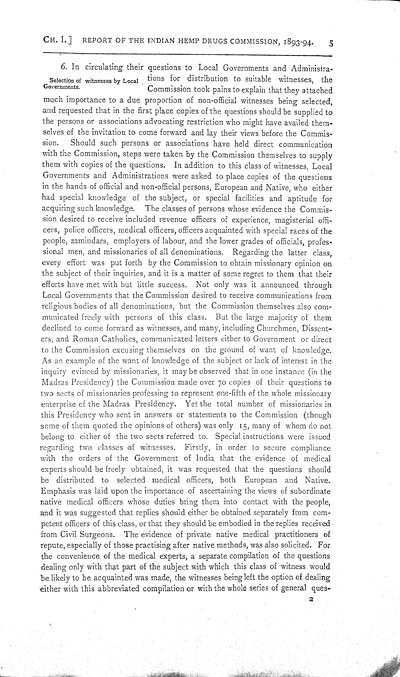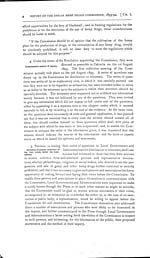Download files
Individual page:
Thumbnail gallery: Grid view | List view

CH. I.] REPORT OF THE INDIAN HEMP DRUGS COMMISSION, 1893-94. 5
Selection of witnesses by
Local
Governments.
6. In circulating their
questions to Local Governments and Administra-
tions for distribution to suitable witnesses, the
Commission took pains to explain that they attached
much importance to a due proportion of non-official witnesses being
selected,
and requested that in the first place copies of the questions
should be supplied to
the persons or associations advocating restriction who might have
availed them-
selves of the invitation to come forward and lay their views before
the Commis-
sion. Should such persons or associations have held direct
communication
with the Commission, steps were taken by the Commission themselves
to supply
them with copies of the questions. In addition to this class of
witnesses, Local
Governments and Administrations were asked to place copies of the
questions
in the hands of official and non-official persons, European and
Native, who either
had special knowledge of the subject, or special facilities and
aptitude for
acquiring such knowledge. The classes of persons whose evidence the
Commis-
sion desired to receive included revenue officers of experience,
magisterial offi-
cers, police officers, medical officers, officers acquainted with
special races of the
people, zamindars, employers of labour, and the lower grades of
officials, profes-
sional men, and missionaries of all denominations. Regarding the
latter class,
every effort was put forth by the Commission to obtain missionary
opinion on
the subject of their inquiries, and it is a matter of some regret
to them that their
efforts have met with but little success. Not only was it announced
through
Local Governments that the Commission desired to receive
communications from
religious bodies of all denominations, but the Commission
themselves also com-
municated freely with persons of this class. But the large majority
of them
declined to come forward as witnesses, and many, including
Churchmen, Dissent-
ers, and Roman Catholics, communicated letters either to Government
or direct
to the Commission excusing themselves on the ground of want of
knowledge.
As an example of the want of knowledge of the subject or lack of
interest in the
inquiry evinced by missionaries, it may be observed that in one
instance (in the
Madras Presidency) the Commission made over 70 copies of their
questions to
two sects of missionaries professing to represent one-fifth of the
whole missionary
enterprise of the Madras Presidency. Yet the total number of
missionaries in
this Presidency who sent in answers or statements to the Commission
(though
some of them quoted the opinions of others) was only 15, many of
whom do not
belong to either of the two sects referred to. Special instructions
were issued
regarding two classes of witnesses. Firstly, in order to secure
compliance
with the orders of the Government of India that the evidence of
medical
experts should be freely obtained, it was requested that the
questions should
be distributed to selected medical officers, both European and
Native.
Emphasis was laid upon the importance of ascertaining the views of
subordinate
native medical officers whose duties bring them into contact with
the people,
and it was suggested that replies should either be obtained
separately from com-
petent officers of this class, or that they should be embodied in
the replies received
from Civil Surgeons. The evidence of private native medical
practitioners of
repute, especially of those practising after native methods, was
also solicited. For
the convenience of the medical experts, a separate compilation of
the questions
dealing only with that part of the subject with which this class of
witness would
be likely to be acquainted was made, the witnesses being left the
option of dealing
either with this abbreviated compilation or with the whole series
of general ques-
2
Set display mode to: Large image | Zoom image | Transcription
Images and transcriptions on this page, including medium image downloads, may be used under the Creative Commons Attribution 4.0 International Licence unless otherwise stated. ![]()
| India Papers > Medicine - Drugs > Report of the Indian Hemp Drugs Commission, 1894-1895 > Volume I > (23) Page 5 |
|---|
| Permanent URL | https://digital.nls.uk/74574114 |
|---|---|
| Description | Chapter I, cont. |
| Description | [Volume 1]: Report. |
|---|---|
| Attribution and copyright: |
|




